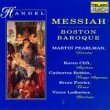AIR (BASS)
The people that walked in darkness have seen a great light. And they that dwell
in the land of the shadow of death, upon them hath the light shined.
The alternating step-wise pitches are continued here, but the motion has broadened some
so that each pair of notes can be perceived to a beat. The result is a “walking” pace and “walking” bass line, supporting the notion of the “people that walked....” The voice and all the instruments are moving in unison, giving this air a bleakness suggestive of a void. “Darkness” pervades the chromatic changes in the pitches of the melody as well as the very low pitches at the cadence of the first vocal phrase: one and a half octaves below middle C! (Some performers choose an alternative cadence on higher pitches here.) [Excerpt 22] The murky tonality is reinforced in rising melody until the next text phrase, when the people see “a great light”; here the D-major tonality takes over. Suddenly, harmony is introduced in the accompaniment. There is a second hearing of the same text, set similarly, but in this second event the soloist’s word “light” is illuminated with harmony. This same text and harmonic progression from “dark” to “light” is given a second time. The next words center around “the shadow of death.” Now the minor key is unrelieved, and the chromaticism and strange stalking leaps continue in the accompaniment. “Death” is protracted in the voice, violas, and continuo basses. The light “shines” briefly in major but returns again to the shadowy world of death to end the air. [Excerpt 23] In this moment of the prophecy there is still a great deal of darkness as the world awaits the promised birth of Messiah.
[Set 4: Chorus (G major), Pifa (C major), soprano recitatives (C major,
F major, A major - F-sharp minor, D major), chorus (D major)]
[Jennens: The appearance of the Angels to the Shepherds]
CHORUS
For unto us a Child is born, unto us a Son is given: and the government
shall be upon his shoulder: and His Name shall be called Wonderful, Counsellor,
The Mighty God, The Everlasting Father, The Prince of Peace!
It’s a toss-up as to whether this chorus belongswith the “prophecy” of the virgin birth or to the announcement of the birth to the shepherds. Its key of G major allows for both options. It could be considered the final chorus of the previous set or scene, making the Pifa the opening of this mini-scene. However, I chose to put the chorus with the fourth scene because of the present tense in the text, which I think sets up the subsequent numbers. This is another of Handel’s self-borrowings. The source is the first movement of his duet Nò, di voi non vo’ fidarmi, from the summer of 1741. Here, too, the oratorio text seems unrelated to that of the duet: “No, I will not trust you, blind love, cruel beauty! You are goddesses who lie and flatter too much.”8
Handel adds two oboe parts doubling the two violin parts and a bassoon to the continuo. The dance-like rhythm suggests buoyancy and joy. Sopranos of the chorus are the first to announce the Child’s birth. Tenors respond briefly, then the sopranos go on with an extended laugh-like flourish on the word “born.” Tenors can only comment in short gasps. [Excerpt 24] The reverse patterns occurs when the basses laugh with the birth and the altos gasp. The government is shown in regal dotted rhythms. Everyone calls the Child by His extraordinary titles in strong homophonic acclamation while the violins laugh and rejoice. [Excerpt 25] At one point, both women’s voices gleefully raise the newborn Child, while the men comment in gasps.
PAGE 1 2 3 4 5 6 7 8 9 10 11 12 13
8 Shaw, Ibid. |

